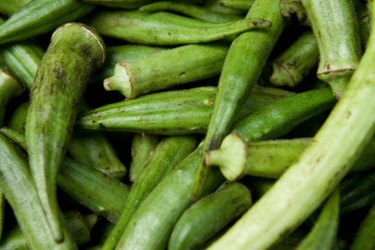
Is okra a vegetable or fruit? Okra is a divisive vegetable (technically a fruit), with a love-it-or-hate-it reputation that causes some to give it a wide berth. The reason for this seems to be okra's most unusual characteristic: its slimy texture. Some don't mind this characteristic of okra, but capable cooks find ways to either mitigate the sliminess or use its thickening qualities to delicious effect. The latter is in play in the classic Creole dish gumbo, perhaps the best-known vehicle for okra. Middle Eastern, Indian, Brazilian and African cuisines among others also embrace the characteristics of okra.
Characteristics of Raw Okra
Video of the Day
Okra is a member of the mallow family of plants, which also includes cacao, durian fruit, cotton, hollyhock and hibiscus. Okra's scientific name is Abelmoschus esculentus, and it's also known as "ochro" or "ladies' fingers," a reference to the long, slim shapes of the plant's edible seed pods. These pods are harvested when they're very young for the best flavor and texture. They somewhat resemble a midsize green chile pepper, with a ridged, tapered shape up to about 7 inches in length, either straight or slightly curved. Okra is bright green with a short fuzz of tiny spines on the exterior, although there are some smooth, spineless varieties.
Video of the Day
Cut across the width of okra to see its pentagonal cross section full of round white seeds clustered around a central rib. The seeds, skin and pale green flesh are all edible both raw and cooked and have a fresh, mild, grassy flavor that gets more prominent with cooking. Raw okra should be crisp, and the pods should snap when you bend them firmly. When you slice or break the pods, you should see okra's characteristic mucilage, or slime, start to release from the flesh. Trim away and discard the hard cap from the top of an okra pod before eating or cooking.
Characteristics of Cooked Okra
The characteristics of cooked okra vary considerably by cooking method. Okra's slimy texture is prominent when it's cooked using low, slow or moist cooking techniques, such as braising or steaming. Cooking okra in this way with acidic ingredients, such as tomatoes, helps to mitigate the sliminess that some find unpleasant. The soluble fiber that comprises the mucilage (or slime) gets incorporated into the liquid of a braised dish, thickening it into a sauce with a texture that's rich and hearty rather than slimy. Cooked in this way, the mild flavor of okra tends to take a back seat to seasonings and stronger-flavored ingredients.
The other way to mitigate okra's natural sliminess is to fry, roast or grill it to a crisp. Some cooks add a coating of flour, cornmeal or batter, but it's possible to get okra crispy and crunchy without coating it. Other preparation techniques to manage okra's characteristic sliminess include rinsing in water, marinating in vinegar, salting and patting dry or simply cutting okra into larger pieces to release less of the soluble fiber. Crispy okra preparations benefit from liberal seasoning with salt, pepper and all manner of spice blends to enhance its mild vegetal flavor.
Okra’s Nutritional Profile
Raw okra has a beneficial nutritional profile, as it's low in calories, high in soluble fiber and an excellent source of several important vitamins. Okra is also a source of protein – 2 grams per cup – which is very uncommon in fruits and vegetables. One cup of okra offers 33 calories, 7 grams of carbs, zero fat and 3 grams of fiber. It provides 26 percent daily value of vitamin C and 26 percent daily value of vitamin K, which support healthy immune function and blood clotting, respectively. Okra is also a good source of magnesium, vitamin A and vitamin B6.
Okra is rich in antioxidants that contribute to heart and brain health, and there is some evidence that its nutritional components can help lower cholesterol and blood sugar. While raw okra is a very healthy food to eat, remember that many of its most common preparations are not quite so favorable.